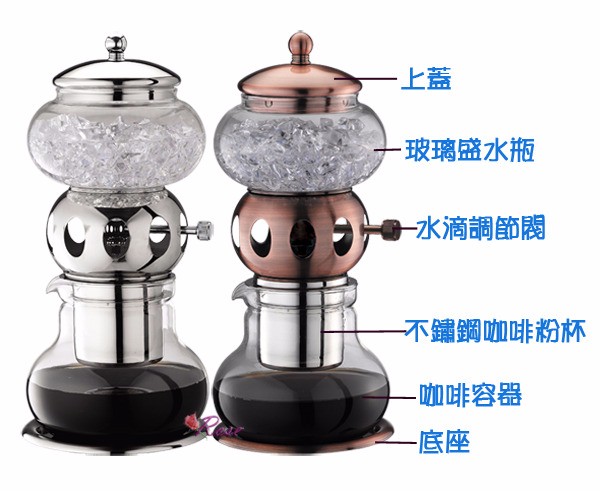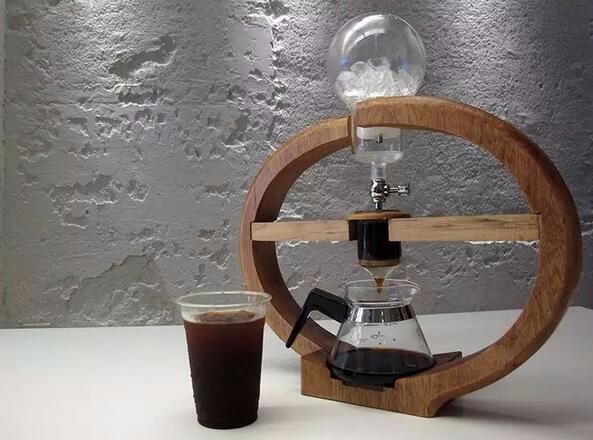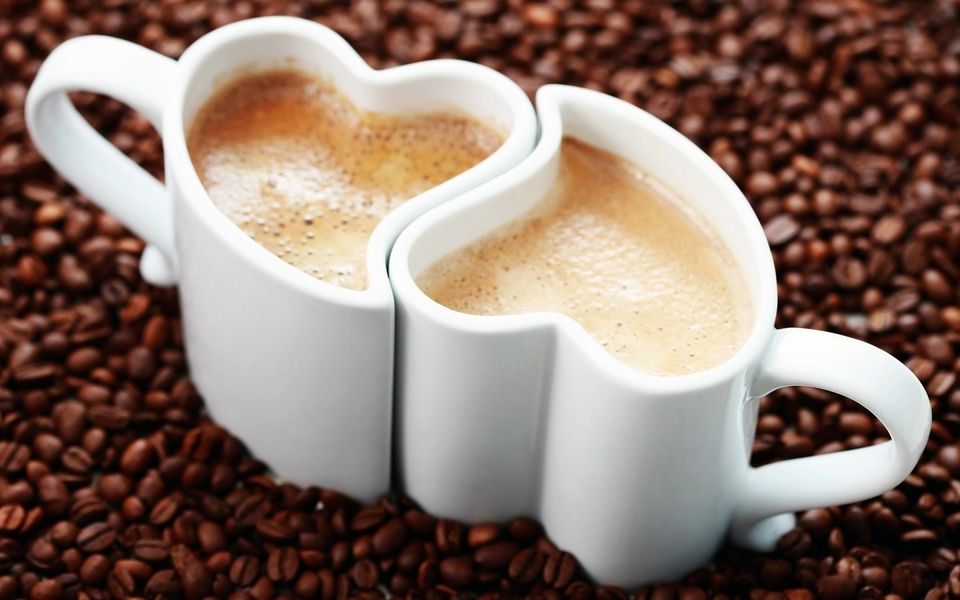How to Make Ice Drop Coffee, Steps to Make Ice Drop Coffee
Follow the caf é (Wechat official account vdailycom) and found that Beautiful Cafe opened a small shop of its own.
The production of ice drop coffee will be relatively troublesome because a special ice drop device is needed.
Materials
Ice drip filter, deep-cultured coffee beans, mineral water, ice cubes.

Production steps
1 grind the coffee beans with a 2-3 scale grinder.
2 put the filter screen into the bottom of the extraction bottle.
Pour the coffee powder into the extraction bottle and flatten the coffee powder.
4 place the extraction bottle on top of the collection bottle, and then place the drip plate on top of the extraction bottle.
5 prepare ice cubes and filtered pure water and pour into the water storage ball at the ratio of 1:1.
6 turn on the control switch to wet the surface of coffee powder evenly.
7 adjust throttle valve to about 40-60 drops per minute is the most suitable.
8. Finish production and enjoy.

Ice drops of coffee being extracted
Extraction secret
1 the ratio of coffee powder to ice water is about 12: 20, depending on your personal preference.
2 in order to increase the contact area between coffee powder and water, the grinding degree of coffee powder is better between siphon type and filter type.
3 because of the long extraction time, it is suitable to use deep-roasted coffee beans, high-grade pure coffee or ice drop special coffee beans.
4 the ice drop coffee is strong at first and then light, so it is necessary to wait for all the ice water to be dripped before drinking the best flavor.
One of the keys to the success or failure of dripping coffee is the dripping speed, with a slow dripping rate of about seven drops in 10 seconds. Water and coffee powder have a long time fusion, coffee taste is more saturated; if the filtration time is too fast, the taste is too light, at the same time will produce stagnant water overflow, on the contrary, too slow will make coffee ferment, produce sour taste and wine taste.
Related readings:
There is an essential difference between iced coffee and iced coffee.
There seems to be a word difference between ice drop (or ice brew) coffee and iced or iced coffee, but the two are essentially different in extraction and should not be confused.
Ice drop (also known as ice brew) coffee is a coffee beverage extracted by soaking in water below 5 degrees Celsius for a long time at a low temperature.
Iced coffee or iced coffee refers to a cold drink coffee that is quickly extracted with hot water and then added with ice or cooled rapidly.
There is a great difference between the two in the way and time of extraction.
1. Hot coffee is made with hot water above 80 degrees Celsius or 85 degrees Celsius Second, it must be extracted quickly, because too slow will cause excessive coffee extraction to cause miscellaneous smell, and the main substance causing miscellaneous smell is tannin, which will be decomposed into pyrosylic acid after boiling, while tannic acid can be easily dissolved and decomposed in hot water. It is the main culprit that causes our coffee to be too bitter, and we generally have to be careful not to extract too much tannin and caffeine. This is the basic common sense that our coffee lovers who have been around for a while know.
2. Ice drop coffee is extracted with a temperature that must be lower than 5 degrees or even close to the freezing point, so the various ingredients contained in the coffee are not easy to extract in ice water, so it is necessary to take the way of fine grinding and slow extraction. the specific method is to soak the coffee powder in ice water for a long time and extract it at a very slow drip rate. The general standard speed is 1 drop per second, 45-50 drops per minute. It usually takes about 8-12 hours. Although it takes a long time to wait, its biggest advantage is that the tannic acid we hate most does not decompose at all in cold ice water, and caffeine decomposes a little in ice water, but it is about 90% less than hot water extraction. there are also many other major ingredients in coffee. It is precisely because there is no astringency in the iced coffee and there is little bitterness in the coffee, so the ice-brewed coffee appears to be very pure in taste, which is also a compensation for a long wait.
Through the comparison of the two kinds of analysis, you can see that the fundamental difference between hot coffee and ice drop coffee lies in the difference in extraction temperature and the content of the substance in the coffee, rather than in the cold drink or hot drink in the end, hot coffee can certainly be cold drink after ice, and ice drop (or ice brew) coffee can also be heated after heating (experts suggest that it is better to heat it through water to avoid causing foul smell by direct heating).
This is why when you want to order a real Dutch ice drop coffee in a coffee shop or hotel, you not only need to book at least one day in advance, but also its price will be much higher than that of ordinary hot coffee. "who knows the liquid in the cup. Didi is hard", this is also worth us to pay a little more money.
How to distinguish between iced coffee and chilled coffee
It is precisely because of this that I often find that baristas in some bad coffee shops or hotels add hot coffee to ice cubes to cool down, pretending to be authentic ice-drop coffee to deceive consumers to make high profits.
In fact, the difference between them is easy to distinguish, there are two ways:
First, after at least dozens of hours of full dripping and fermentation, the real ice drop coffee will have an unspeakable and strange aroma immediately after opening the bottle, which is the kind of aroma that hot coffee absolutely does not have, and this aroma cannot be copied in any other way. Unforgettable. So when you doubt whether it is a real ice drop coffee, ask the barista to bring up the original ice drop coffee without sugar and milk and smell it first.
Second, the taste and feeling, ice drop coffee does not have any astringency, very little caffeine content, taste very clean and refreshing, that is, even drinking a few cups will not have any palpitations or insomnia and other negative effects. Hot coffee with ice only lowers the temperature, but caffeine and tannin are not reduced, and there will be a significant difference in taste and feeling after drinking.
The origin of ice drop coffee
On the Indonesian island of Java, which was once a Dutch colony in the 17th century, it is said that the coffee extraction method used here was introduced by Dutch businessmen, so it was named Dutch coffee Dutch Coffee. This kind of coffee drips with ice water for a long time, so it is also called "coldbrew coffee cold" or "water drip coffee".
Ice drop coffee is a coffee that is dripped in ice water for 8-12 hours at room temperature. although the aroma is not strong, it emits a unique aroma, which is not available when extracted with hot water. The biggest advantage of this kind of coffee is that it is quite pure and has no extra flavor, but it can give full play to all the ingredients in the coffee.
There are two ways to extract ice-drop coffee. One is the traditional method that is still used in many parts of Indonesia today-- putting the coffee in a lead bucket and dripping. The other is to use the all-in-one machine to drip (that is, the ice drip kettle we often see in coffee shops, it consists of a glass kettle containing ice water with a drip switch, a glass pot containing coffee powder and connected to a glass serpentine bend, and finally dripping to a glass flask. Using the dripping principle of ice drop coffee utensils, people can not help but think of laboratory tools, the function is good, the appearance also looks quite spectacular, just these can stimulate my curiosity. Ice droplets are made with a variety of tools, but the price is quite high, mainly made and sold by Japanese businessmen.
From this point of view, "coldbrew coffee cold" or "water drip coffee" both refer to the same meaning, and there is no essential difference, just different expressions and names of the same thing.
If there is a difference, I think the term "ice brew" covers a wider scope, which can refer to both ice droplets and cold bubbles.
Toddy cold bubble pot is the most convenient tool for iced coffee.
Soaking and extracting in ice water is another way to make iced coffee in Java and other parts of Indonesia, called the traditional cold brew. It does not require any technology or organs and is the most natural way to extract coffee.
Todd Simpson, on a business trip to Guatemala in 1962, ordered coffee in a restaurant. However, all that stood in front of him was the black extract liquid in the pot and the hot water that had just been boiled. The clerk poured the hot water into the black liquid and handed it to him. He could not forget the smooth and full-bodied taste of the coffee he drank at that time, so he studied it in depth when he got home. In fact, the coffee-making method he drank was commonly used by the Dutch who settled in Java in the 19th century. He named the tool he invented Toddy. In Seattle Gourmet Coffee and Jean Coffee Beans, the cold-soaked coffee extract used for iced coffee is also a fan of Toddy.
The common point between ice droplets and cold soaks is that coffee liquid is extracted by soaking coffee powder in ice water. the two production methods have their own characteristics, the ice drop method is magnificent and the taste is pure and natural; the cold bubble method is simple and smooth in taste, especially suitable for home and office.
Important Notice :
前街咖啡 FrontStreet Coffee has moved to new addredd:
FrontStreet Coffee Address: 315,Donghua East Road,GuangZhou
Tel:020 38364473
- Prev

How to self-make cold-extracted coffee, a simple method of self-made cold-extracted coffee
Cold coffee sounds high-end, but in fact it is very simple to make. The materials you need to prepare are: coffee powder (it is recommended to use single coffee) refrigerated pure water (it is said that mineral water is not conducive to flavor extraction) filtration equipment (filter paper or French pressure pot or hanging ear coffee) cup brewing steps: take the French pressure pot as an example, put 10: 12g coffee powder into the French pressure pot 2, pour into 180m
- Next

Coffee Learning: the History, legends and stories of Coffee
The early historical records of coffee are almost zero, so those are the stories that modern people know. As for what the facts are, there is no way to know. But we can also make some guesses about those legends, after all, this is almost the only way to know and explore the truth now. We can understand the history of coffee from several aspects.
Related
- What is the meaning of lactic acid fermentation with coffee bean treatment?
- How to judge the state of foam by sound?
- How does the latte pull out the unicorn pattern? Come to get for a little trick to improve the flower pull!
- Will flower pulling affect the taste of the latte?
- Do you know the history of coffee?
- The difference between honey treatment and sun washing what is raisin honey treatment?
- What kind of milk can a novice use to make coffee foam to keep the foam longer? The correct method and skills of milking tutorial sharing
- Why do washed coffee beans taste sour? Flavor characteristics of washed Coffee
- Introduction to the skill of how to practice the size and height of water injection around the circle of hand-brewed coffee
- How do beginners practice coffee flower drawing from scratch?

